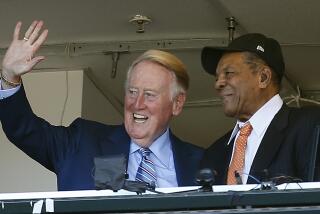With Dodgers announcer Vin Scully, it’s always more than pleasant good
- Share via
Hi, everybody, and a very pleasant good afternoon/evening to you, wherever you may be.
That is how Vin Scully, who begins his 62nd season as the Dodgers’ announcer this week, starts his broadcasts. He called his first Dodgers game when they played in Brooklyn, during the Truman administration, and he has seen the team through the move to Los Angeles, games in the Coliseum, riots, wildfires, earthquakes and seismic shifts in team ownership. In more than 10,000 games behind the Dodger mike, he has called three Sandy Koufax no-hitters and a Koufax perfect game. He called Don Larsen’s perfect game in the 1956 World Series, Hank Aaron’s 715th home run (to pass Babe Ruth) and Kirk Gibson’s miraculous homer in the 1988 World Series (“She … is … gone!”).
When I moved to Los Angeles from Philadelphia in 1971, I was a disaffected Phillies fan, still reeling from the 1964 collapse in which my team blew a 6 1/2-game lead with 12 to play. The Phils managed this megaflop by losing 10 straight games, seven of them at home. A thwarted lover unable to commit, I could not plight my troth to the Dodgers. I became a Vin Scully fan instead.
In those days Vin did both TV and radio, but not simultaneously, so true fans switched back and forth between the television feed and the radio. When the Dodgers were in the playoffs or on the network game of the week, you muted the TV in favor of Vin’s radio call.
Vinny — the fan intends no disrespect — is gifted with such powers of description that he is called “the poet laureate of baseball.” But he knows when to keep quiet: He uses crowd noise the way a painter uses negative space, silently letting the energy resonate. He also knows precisely when to start talking again in that genial baritone, speaking just to you.
Vin wields statistics deftly, not to impress but to illuminate. His repertoire of “stats ‘n’ stories” is abundant but finite, and he’s quick to apologize for the inevitable repetition. He need not worry: The fan revels in his retelling of stories that have grown as comfortable as an old pair of slippers. A master storyteller whose vivid language conjures a whole world, his observations about the game and the men who play it reveal his incredible range.
He fires off one-liners:
“[Roberto] Clemente could field the ball in New York and throw out a guy in Pennsylvania.”
Bob Gibson “pitches as though he’s double-parked.”
“Tom Glavine is like a tailor: a little off here, a little off there and you’re done — take a seat.”
“The Dodgers are such a .500 team that if there was a way to split a three-game series, they’d find it.”
He philosophizes:
“Andre Dawson has a bruised knee and is listed as day to day. Aren’t we all?”
“It’s a mere moment in a man’s life between the All-Star game and an old timers game.”
But he never gets in the way of the occasion:
“On the scoreboard in right field it is 9:46 p.m. in the city of the Angels, Los Angeles, California. And a crowd of 29,139 just sitting in to see the only pitcher in baseball history to hurl four no-hit, no-run games. He has done it four straight years, and now he caps it: On his fourth no-hitter, he made it a perfect game. And Sandy Koufax, whose name will always remind you of strikeouts, did it with a flurry. He struck out the last six consecutive batters. So when he wrote his name in capital letters in the record books, that ‘K’ stands out even more than the O-U-F-A-X.”
Baseball is a quotidian game, and moments like a Koufax no-hitter are so rare as to be statistically insignificant. Most of what happens between the lines is unremarkable by any objective standard. But game by game, inning by inning, Vin makes it all special. He paints a picture, and his signature expressions are the brush strokes.
Jon Winokur is the coauthor, with James Garner, of “The Garner Files,” to be published in the fall by Simon & Schuster.
More to Read
Go beyond the scoreboard
Get the latest on L.A.'s teams in the daily Sports Report newsletter.
You may occasionally receive promotional content from the Los Angeles Times.










